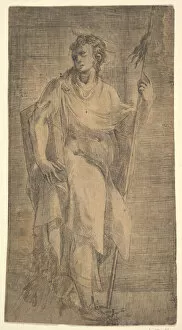Andrea Schiavone Collection
Andrea Schiavone, a renowned Italian painter of the 16th century, left behind a rich legacy of captivating artworks
All Professionally Made to Order for Quick Shipping
Andrea Schiavone, a renowned Italian painter of the 16th century, left behind a rich legacy of captivating artworks. His mastery is evident in pieces such as "The Flight into Egypt, " where he skillfully captures the emotional journey of Mary and Joseph. In "The Finding of Moses, " created by Battista del Moro but influenced by Schiavone's style, we witness the dramatic moment when Moses is discovered among the reeds. One cannot overlook Schiavone's ability to depict religious scenes with great detail and sensitivity. In "The Marriage of Saint Catherine, " he presents a sacred union filled with divine light and heavenly grace. Similarly, in "Christ Healing the Lepers, " his brushstrokes convey compassion and hope as Christ brings healing to those afflicted. Schiavone also excelled at portraying historical events like St. Paul Preaching in Athens. This powerful composition transports us back to ancient times, capturing both the grandeur of Greek architecture and the intensity of Paul's message. In addition to religious and historical subjects, Schiavone explored themes from mythology and everyday life. The Adoration of the Magi showcases his ability to infuse mythological figures with human emotion while maintaining an air of mystery. Beyond these well-known works, there are other intriguing pieces attributed to him that showcase his versatility as an artist. Busts depicting women flanked by others demonstrate his attention to intricate details within elaborate frames. A young woman drinking from a bowl while an old woman stands nearby reveals his interest in capturing intimate moments between individuals. Schiavone's fascination with strong female figures is further seen in paintings like The Cumeaean Sibyl walking gracefully followed by three women or Cupid viewed from behind holding an arrow poised for love's strike. Although some attributions may be debated due to limited documentation during this time period, one thing remains certain: Andrea Schiavone's artistic talent and unique style continue to captivate audiences centuries later.
















































